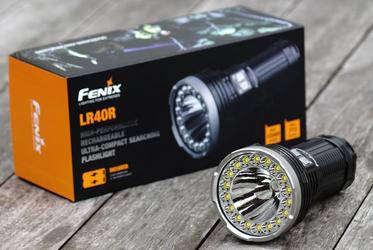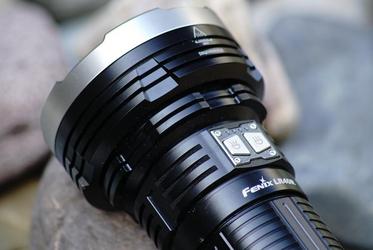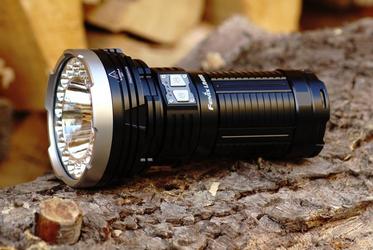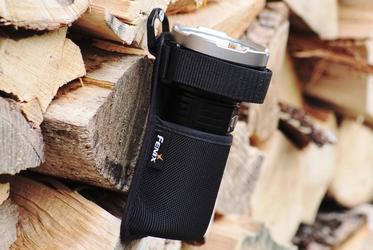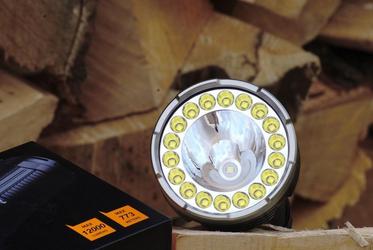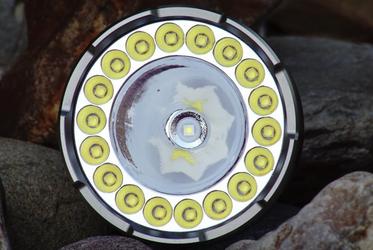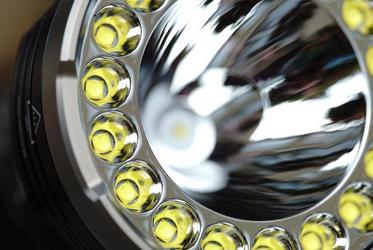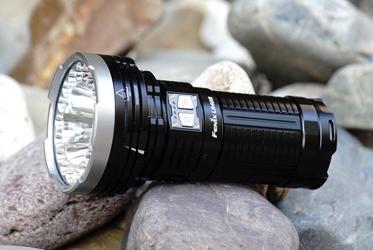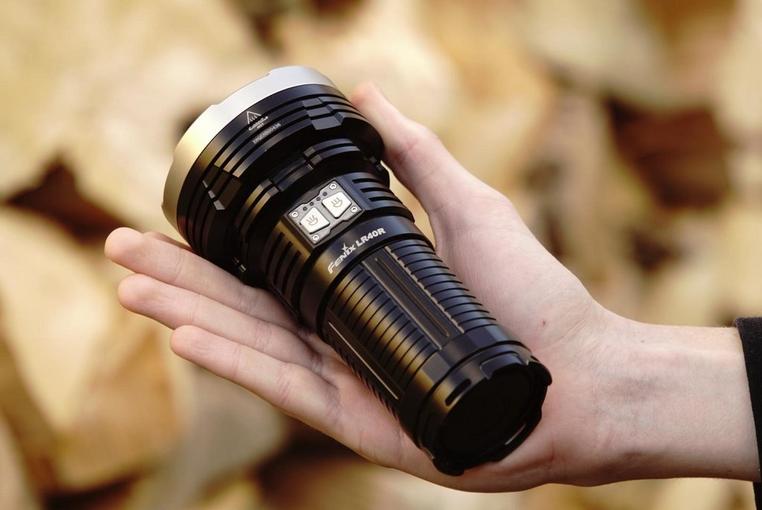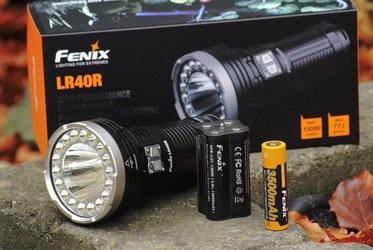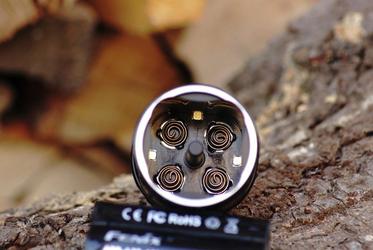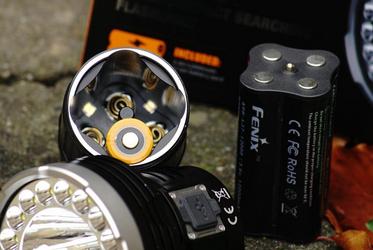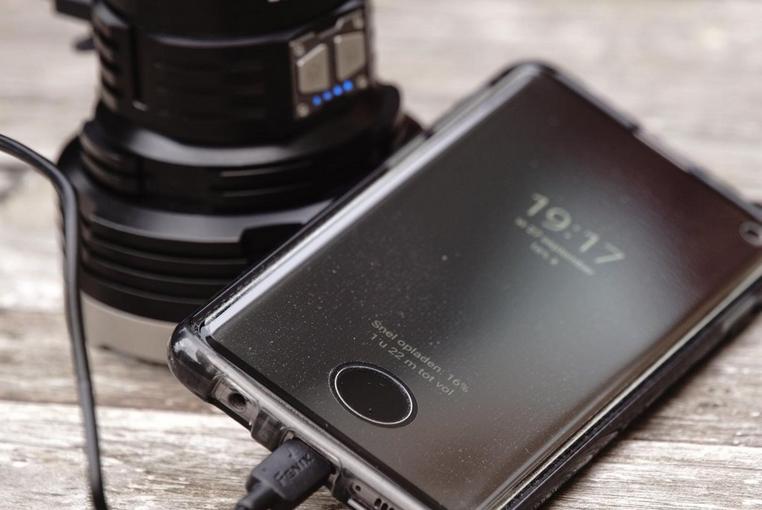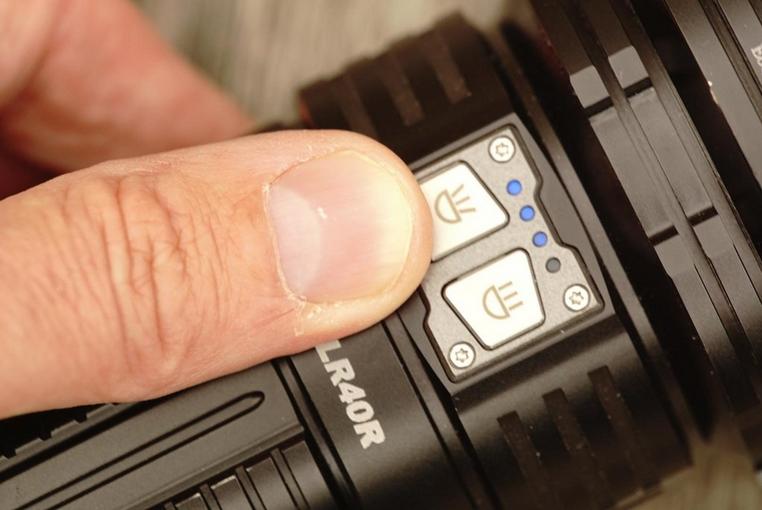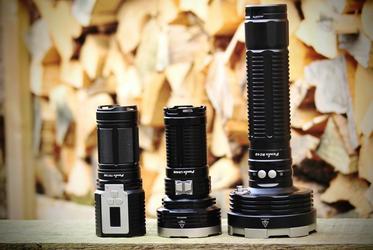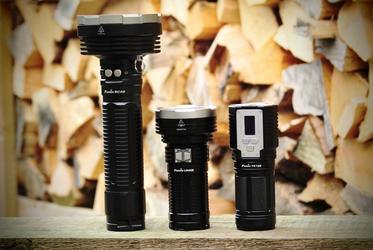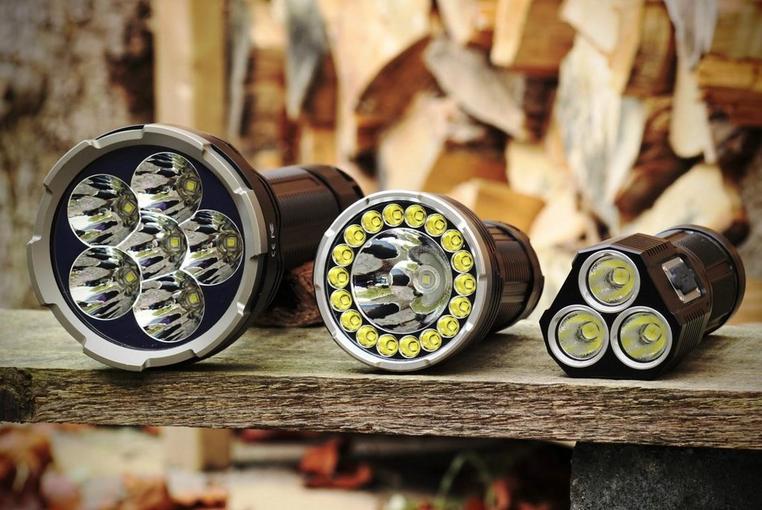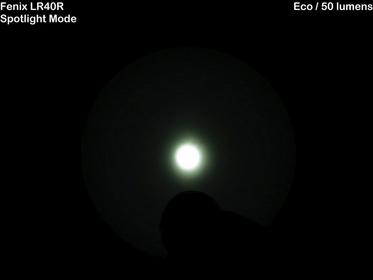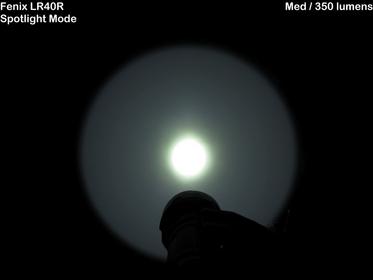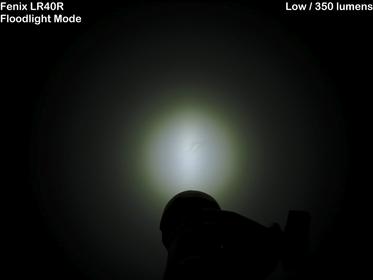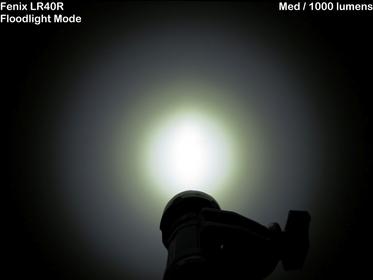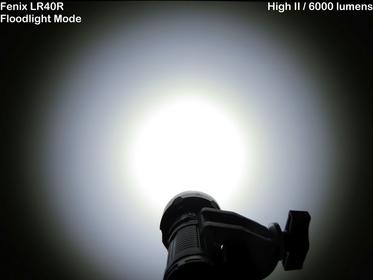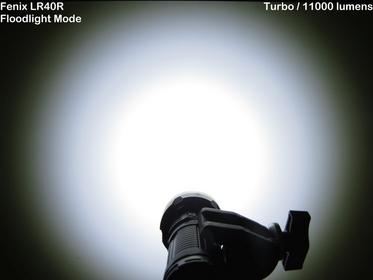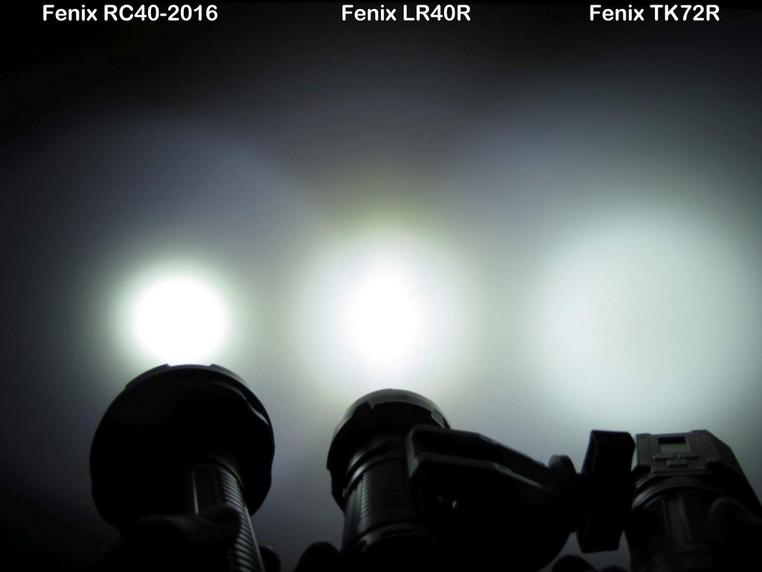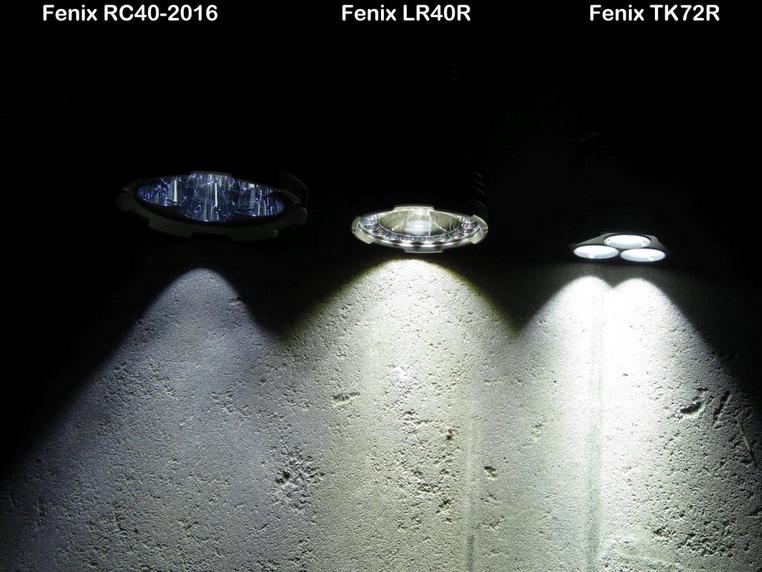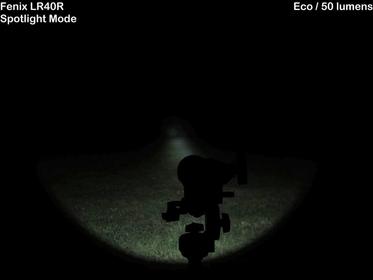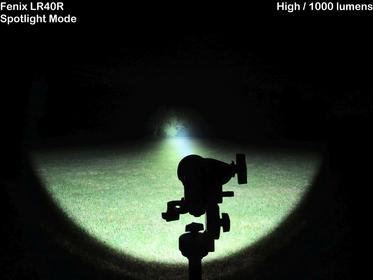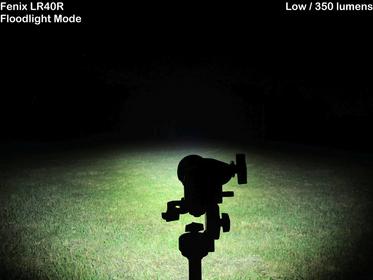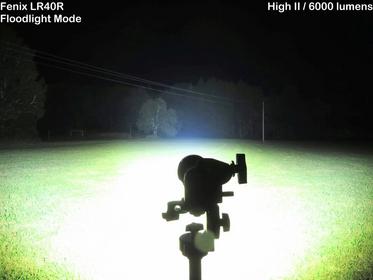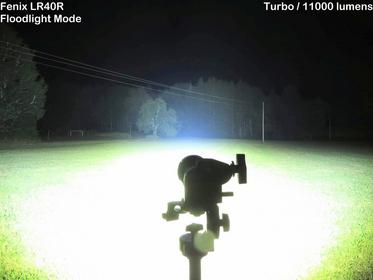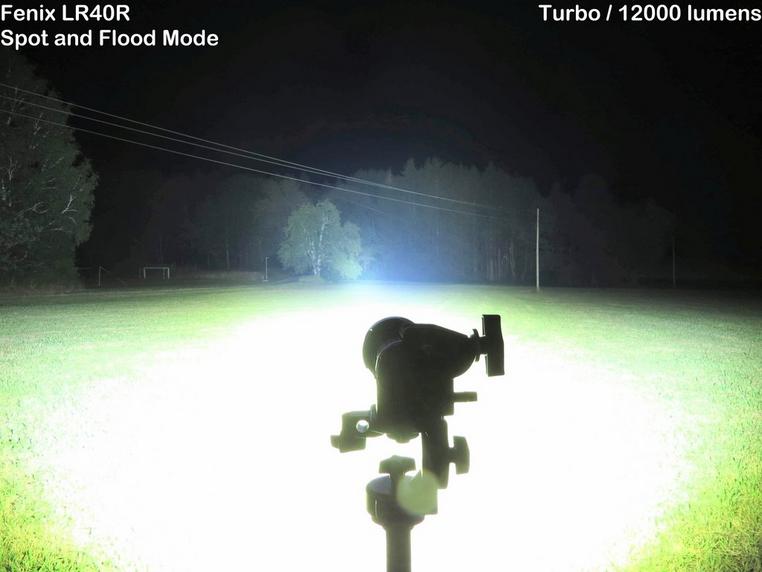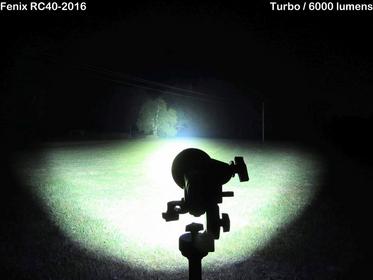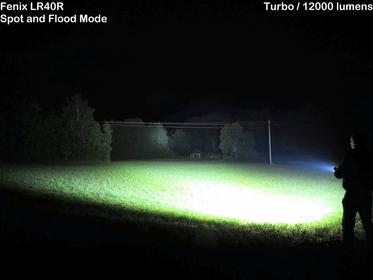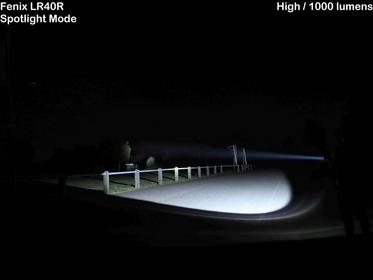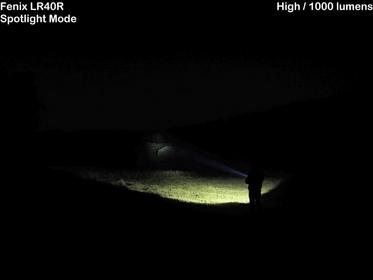Fenix LR40R | Expert Review by Koen van der Jagt
It is not that long ago that a flashlight with an output of a couple thousand lumens was labelled as 'impressive'. However, thanks to more powerful light sources and batteries new techniques are developed every day. The Fenix LR40R is the first ever Fenix light that breaks through the 10.000 lumen barrier. And that is truly a massive amount of light, something I will show you later on in this review. As we have grown accustomed to from Fenix this product is also enhanced with something special: two light profiles in one light. One for close by and one for far away.
Because a lot of output is often at the expense of the beam distance, Fenix came up with the best possible solution! Now you can choose: a massive amount of light up close, or a concentrated beam that will reach hundreds of meters. But you can also combine beams which is what makes this light canon so unique! The LR40R is also a very powerful powerbank thay will effortlessly charge your smartphone or tablet. Curious to learn more about my finds and experience what this new Fenix can do? Continue reading!
Unboxing
The LR40R is wrapped in a big and strong cardboard box. The plastic case that held the TK75, for instance, is a thing of the past. I don't mind, especially in a time where the use of plastic needs to be avoided. On the box we spot a couple of action shots where the light is used and find most of the specifications. We immediately notice the beam distance, something Fenix felt was definitely worth mentioning twice. Striking is that this 773 meter is not mentioned in the runtime and output schedule on the back of the box, this is namely the range of the light when it uses all LED lights at full strength. The LR40R is stored in the holster and the battery is also placed inside the light. Other than that there is not much else to find in the box. Of course a carrying strap, a charging cable and the usual documents.
You can easily open and close the box, you fortunately don't need scissors. A downside is that a charger is missing; I guess Fenix assumes that everyone owns a powerful charger with about 2 to 3A. I would have preferred to see that charger... Other than that it looks good. Below a couple of pictures of the LR40R-box!
First impressions
The LR40R looks like a real Fenix descendent and therefore fits well with the rest of the large family. The design reminds me of the TK75 most, which I also reviewed for Knivesandtools. I also spot features of the RC40-2016 and the TK72R. In my eyes another great design, the deep black colour looks great. A nice development is also that the light, despite its higher output, hasn't gotten bigger but more compact.
The LR40R is a large, slightly heavier light you won't easily carry around in your pocket. It is for a reason that it comes with a holster which you can easily attach on your belt. Thanks to this accessory you will always have your light close without it getting in the way. It also feels great in hand and you can easily reach both switches. Because of the difference in structure on the body and the head of the light the light won't easily slide out of your hand, even while wearing gloves.
Thanks to its size the LR40R is also very stable, even when you place it on a less even surface it stays upright. With an (improvised) diffuser you can, as such, also turn it into a camping light. The type number is engraved underneath the switches, and you will also find some additional information on other places on the body; fortunately not too noticeable, because it does affect the look and feel of the light. With this light you once again notice the quality when it comes to the finish: the light looks great and all parts fit neatly together.
Just below the head of the light we find the 'control panel' enhanced with two switches you use to control the light. Today Fenix makes them from metal which makes the light even more sustainable. The switches differ in shape to make sure you don't accidentally use the wrong one in the dark.
On top of the switches you find four small (blue) LED lights that show you the status of the battery. You can check the battery status in the standby mode and when the light is turned on. Mirrored on the switches you will find the charging port and the USB-out. These are covered by a rubber cap, but also without this protection they are protected against water. The LR40R has the IP68 rating, which will definitely come in handy for intensive users in harsh or humid conditions.
The head of the light is the eye catcher of the LR40R. We see a relatively deep and smooth reflector in the middle and a structured edge around the light source. As such this becomes a separate reflector in a reflector. This combination with the flat XP-L HI V3 LED light takes care of a narrow beam with a massive range. In the edge I spot no less than 18 XP-G3 S4 LED lights, all with their own shallow reflector. This combination of LED light and reflector leave you with a scattered beam, and that times 18. The result is an incredibly broad beam! I saw that for my version not all LED lights were precisely centred but fortunately I didn't see any of that in the profile of the light.
When opening the light you immediately notice that the LR40R retrieves its power from a battery pack. These are actually four 18650 batteries that are tied together with the help of a holder and protective foil. The battery pack falls over a metal pole in the casing so it always sits securely and does not rattle during use. Because the use of a battery pack is often criticized, because in case of an emergency you often haven't got a spare close, Fenix added a great solution. The LR40R namely also works with one to four 18650 Li-Ion batteries! As such you don't immediately have to order a matching spare battery, but can also use one to four 18650 batteries. Of course you won't be able to use the highest light modes with fewer batteries, but you can use random (button-top) spare batteries in case of an emergency. Quite the reassurance.
I, of course, tested this and used the light with a single 18650 3500mAh Li-Ion battery. The (single) XP-L HI V3 works with one battery in all light modes. With the 18 XP-G3 S4 LED lights (which draw much more power from the battert) I was only able to reach the medium mode of 3000 lumens. In case on an emergency you will, as a result, always have enough light by using a spare battery.
When I look closer at the inside of the light I also notice how Fenix nicely puts its products together and properly finishes them. The battery is nicely secured in place and is protected from outside blows with the help of the gold-plated springs. I always recommend users to grease the screw wires because it will extend the life of your light. By the way: most users will probably never open the light because you don't have to remove the battery to charge it.
Conclusion of this paragraph: The LR40R is a decent flashlight that can withstand very harsh conditions. Also check out my photographs below to learn more about the LR40R and its remarkable traits.
Controls and options
The dimensions and the weight of the LR40R are comparable with the TK72R, even though the LR40R clearly has a broader head. Quite a large and heavy light but it still feels great in hand. Compared to the TK72R it feels a little more 'solid' in hand thanks to the structure of the body. During long trips I recommend wearing the light in the holster on your belt to make sure the weight doesn't work against you.
Charging the light is easy and doesn't require any additional information. You use the included cable or a random USB-C-charger, plug it in and the rest will happen automatically. Charging an empty battery will take about three to four hours. To make sure you are not completely without light as you charge the LR40R, you can continue to use the two lowest modes of the spot mode. A great option is that Fenix has ensured that the light also functions with one to four 18650 batteries. The LR40R has a great battery which, with average use, lasted for a couple of weeks as I tested it. During intensive use you need to charge it more often, especially the flood mode will retrieve a lot of power from the batteries.
If you intend to use the highest modes for long periods of time you need to charge the light on a daily basis, and could consider getting a spare battery. In the lowest and middle modes (which should, in most cases, be enough) the light will last quite a lot longer. Today charging a battery often is more good than bad, which is why I always ensure that the light is properly charged. If you want to know the battery status: a short click on one of the switches gives you an update of the battery status. With four lights the battery is fully charged, if only one light is still blinking you quickly need to charge the battery because that is when the LR40R will almost stop working. Even after turning the light on you immediately see how full or empty the battery is.
The light is also quite intelligent: when the battery is running low the light will automatically switch back to a lower light mode. As such you will always be able to use the light as long as possible. When you reach the lowest mode (Eco), the indication light on the left will start to blink. As such you immediately know that you quickly need to recharge the light. In reality this works quite well, but I would still like to make sure the light is always charged in time.
The LR40R will also switch back when it gets too warm. It needs to because the many built-in LED lights develop a lot of heat in the higher light modes. This security feature, which is connected to the flood mode, is time related. In the turbo mode the light will automatically switch back to a lower mode after two minutes. In the second highest mode after five minutes.
Even when the temperature of the LR40R reaches above 65ºC, the light will automatically switch back to a lower mode. As such you also protect your hands and the material from the heat. The light will switch back to quite a lower mode of 1500 or 1000 lumens. This does depend on whether the spot mode is also turned on at the same time or not.
As I was testing it I noticed that in the maximum mode of 12.000 the light does get hot quite quickly. This mode is truly meant to shortly highlight whatever needs to be highlighted. If, for instance, you use the light in the (combined) mode of 4000 lumens, you do use a bright beam for quite a while. The advantage when compared to smaller lights is that the LR40R lasts a really long time in this mode, while, for instance, the UC52 from the middle class is unable to do so. Here you can clearly see that large(r) lights are at an advantage here
The other incredibly practical function is the built-in powerbank. This is definitely not a 'throw-away' from the supermarket that is often of little use, but a powerful charging station that will also easily charge larger smart phones or a tablet. I tested it with a Samsung S10 and it was charged in only one hour. A fully charged LR40R has enough power to charge a phone multiple times and will still function whenever you might need it afterwards.
The smaller switches can easily be controlled with your thumb. They contain icons that tell you whether you activate the flood or spot mode. These symbols, however, are invisible in the dark. As such illuminated switches would be a great solution. The controls work as we are used to from Fenix: you turn it on and off by pressing the button for a mere second. You select the preferred light mode by clicking shortly when the light is turned on. It doesn't take a lot of getting used to, it is quite simple.
The switches work independently of each other, this means that you can use and combine the flood and spot mode separately. In the flood mode you have five light settings, the spot has four. A really low, and energy efficient mode is missing which makes the LR40R not that great for use indoors. But that is also not what it was designed for. I do hope, however, that someday Fenix will come up with a type of moonlight-mode.
If you press the left switch you activate the stroboscope mode - it is literally blinding. The next click will take you to the SOS mode, after which you return to the normal light mode. When you turn the stroboscope on you deactivate the spot mode. Directly reachable light modes are missing on the LR40R, so if you wish to turn to the maximum output mode from the lowest mode you need to click seven times in total. There should be a faster way.
When you press both switches at the same time the LR40R will be 'locked'. As such you make sure that the light won't accidentally turn on during transport. You can also lock the light itself by slightly loosening the body. Operating the LR40R is pleasant and effective. I would, however, have loved to see a lower mode and a so-called 'momentary-on' mode that will turn on the light if you press down the button. Great for shortly illuminating objects.
Comparison
As a comparison I already mentioned two other big boys from the Fenix family: the Fenix RC40-2016 and the TK72R. Because I also used these three during the 'outdoor-sessions' I will show you the main differences between the three with the help of some photographs.
Standing next to each other you immediately notice the difference in length between the RC40-2016 and the two others.
The triangular head of the TK72R is the smallest by far because the light has only three reflectors. You also notice the deviating structure of the less deep reflectors, the so-called 'orange-peel'. This tells you that the beam distance of the TK72R will be shorter than that of its big brothers.
The backs also differ. The back of the RC40-2016, for instance, is enhanced with usb-ports and a powercheck. With newer lights you often find these on the side. Perhaps a better and safer solution in case the light falls from your hand.
Light image and beam shots
With so many options it is interesting to compare the light image of all three lights. The LR40R has two profiles in one light, which is exactly what makes it so interesting. The single XP-L HI V3 leaves you with a reasonably deep, smooth reflector for the 'throw' of the light. A narrow beam with a bright and concentrated spotlight. In reality this leaves you with a beam which reaches quite far, and because you don't highlight yourself you can see even further.
The colour of the light is cold white. This is the best option if you want to reach far. The 18 XP-G3 S4 LED lights in the edge of the head of the light create a beam I had never seen before. What a massive amount of light! It is basically one large hotspot, which results in an enormous beam at shorter distances. The light is clearly less cold than that of the XP-L HI V3 and looks a little more pleasant. Below my 'wall shots': The LR40R pointed at a white wall to make sure you can clearly see the colour and the profile of the light.
First the four modes in the spot mode. As said before, a bright and clearly outlined hotspot that abruptly turns into the residual light (the spill). Little light up close and a lot of reach. In the flood mode we see something else entirely. A massive hotspot and a large corona, with barely any spill. Less reach but a massive amount of light at short and medium distances
A comparison clearly shows you the differences in the profile and colour of the light. The RC40-2016 has the largest hotspot and will provide you with the most amount of light at large distances. The LR40R has a small but bright spot in the larger hotspot: a lot of light at medium distances plus a lot of reach at the 'tip' of the beam. The TK72R has a more even profile without a bright spot: As such this light provides more light at shorter and medium distances but cannot compete with the others in terms of beam distance.
A photograph from above once again shows you the colour of the light. You can tell that the RC40-2016 has the coldest shade and the LR40R the warmest, thanks to the 18 XP-G3 S4 LED lights.
Let's head outside! To demonstrate the enormous power of the light I tested the LR40R at a couple of spacious locations. The first location is a patch of grass with a forest located about 150 meters away. We will start with the spot mode. You immediately notice the narrow beam that will enable you to look for and light up objects in a very targeted way.
In the flood mode we see a lot more power. Here you also clearly see the differences in the image of the light. Compare, for instance, the two lowest light modes of the spot and flood mode. You can clearly tell that the LR40R also reaches the lower rim of the trees in the lowest mode of the spot mode, with the flood mode this only occurs in the higher modes
It is also great to learn more about the difference between the maximum output in the spot mode, the flood mode and both paired. You can tell that the spot mode definitely adds to the flood mode, and as such you are left with a hotspot in the hotspot. This, of course, leaves you with a lot more reach which is great during search ops from a high point. Up close you can light up everything while at great distances you can specifically search for things.
Now let’s compare the LR40R with the other Fenix canons! First the RC40-2016 compared with the LR40R. We start with the lights mounted on a tripod and afterwards the same comparisons, but now with the lights in hand to get a better idea of the proportions. The beam distance and the width of the beams becomes even clearer when you look from the side.
The beam distance of the RC40-2016 is a little better than that of the LR40R, but that is mostly because with the RC40-2016 multiple LED lights are concentrated in the hotspot. Or, to put it differently: The RC40-2016 'throws' 6000 lumens over the entire distance, while the LR40R only has 1000 lumens. The LR40R, however, illuminates a larger surface at short and medium distances. Here you can clearly see that the LR40R, when compared to the RC40-2016, has twice as much power
The TK72R has an even and broad beam, but cannot compete with the LR40R in terms of beam distance. This is the result of the used XHP70 LED lights and the central XP-L HI V3 Led light that the LR40R is enhanced with.
I tested the LR40R at multiple locations, below you can see the results at a soccer field. The difference in output is clear. In the flood mode you can easily highlight the athletes.
The next location is a sloping area with a forest in the background. The camera is located a little further away to highlight the impressive performances of the LR40R even more. First the spot mode again. The tree the light highlights is located approximately 450 meters away.
With the light in the flood mode you can see that it illuminates a much larger surface. Most light is located at a short distance, but also the trees located about 450 meters away are clearly illuminated.
I also turned on the spot mode and immediately lit up the top of the tree, and the total beam reached even further.
Conclusion
I am impressed! In terms of build and finish there isn't really that much to say: this is simply just great. The multiple battery options are also a plus. You can even use the light with one 18650 Li-Ion battery! The controls are easy and practical, even though I do miss a direct turbo mode and a momentary-on mode. A lower light mode is also something still missing. The powerbank option, however, is great.
Especially the flood mode is impressive. The LR40R produces an amazing amount of light! If it has to this light will light up enormous surfaces and it also has an excellent beam distance. I do believe that the spot mode reaches its full potential best if you only use this mode. It namely enables you to search more specifically without blinding yourself or others. In combination with the flood mode the spot mode kind of has to take a step back amidst all that light. It is when you can clearly tell that 'only' 1000 lumens are produced by the XP-L HI V3 LED light. If you need a lot of a light at larger distances the TK75-2018 or the RC40-2016 could be a better fit. You do, however, have half the amount of lumen at your disposal.
I hope that with my story I have given you a clear idea of what the most powerful Fenix light ever can do. One thing is for sure: The LR40R is absolutely incomparable! Special thanks to Knivesandtools for supplying me with the Fenix LR40R
Koen van der Jagt
Ever since he could walk Koen has been interested in lights, wires and batteries. As a child he was always working with dyno torches, bike lights and electrical boxes. The krypton and halogen lights were replaced by LED lights. A couple of years ago he discovered the ‘professional’ stuff. His first brands were Led Lenser and Fenix. Photography is also one of his hobbies. In addition to nature and meteorology Koen loves to show others what a light can do and what its beam looks like at night. Koen’s reviews can often be found on forums such as candlepowerforums.com and taschenlampen-forum.de. Throughout the years Koen has collected lights in practically any category: from small and compact to enormous powerhouses.

